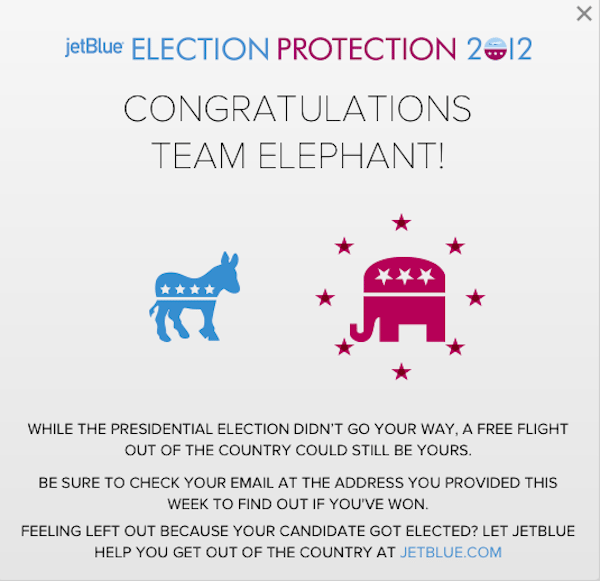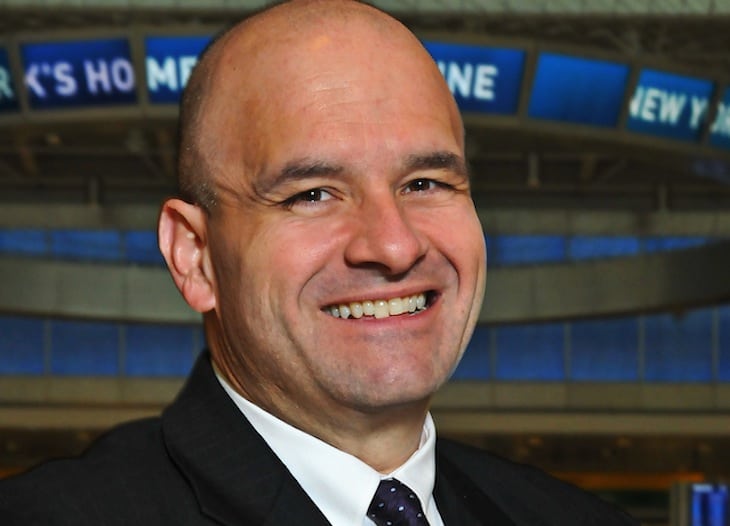Skift Take
JetBlue doesn't want to be JCPenney. The airline certainly wants to attract more business travelers, but it adamantly seeks to ensure that changes don't come at the expense of its leisure traveler customer base. The balancing act will gradually become more of a challenge as Mint service expands, but it isn't a huge issue for the moment.
Marty St. George, JetBlue‘s senior vice president of marketing and commercial, has been at the airline for seven years. With his inclusion in the Skift50, we caught up with him to discuss some of JetBlue’s headline-grabbing campaigns over the last couple of years, and to delve into the status of the brand.
Skift: What were some of your signature marketing campaigns over the last year or so?
St. George: Election Protection was during the presidential campaign. It went almost completely viral. We didn’t spend a lot of money on it. Election Protection came from one of those simple insights: What do people say during every presidential election? If the other guy wins I’m leaving the country.
Our idea was sign up, tell us who your candidate is and if he loses, we’ll give you a free ticket out of the country. We gave away 2012 roundtrips to leave the U.S. to 19 different destinations around the Americas, and it was good for right before the Inauguration. It was a fantastic viral campaign. People immediately seized on it. I think the best marketing programs you can come up with are ones that lead to an immediate visceral reaction. You totally get the situation.
Skift: When you say it went viral, what were some of the metrics on that?
St. George: We had very little paid media on it. Between being on CNBC and FOX, we had hundreds of millions of impressions. We did a little paid media and we only did it in New York.

Skift: What was the goal of the campaign?
St. George: We wanted to make sure that were were part of the conversation. There are a couple of things I liked about it. First, we established the fact that we fly to all those places besides New York to Florida. Second, I think it burnished the brand. We want customers to look at it and say, ‘Only JetBlue could have pulled that off.’ We like the impressions, too.
Skift: The perennial question: How do you create a campaign designed to go viral?
St. George: I could tell you but then I’d have to kill you. No, I think the story is you really never know. The most important thing you do is foster an environment where everyone is always thinking and trying to come up with ideas that they think can meet the goals of certain ideas that JetBlue is trying to communicate and that people will really respond to.
I think a great example is of something we are trying to create is a campaign called Car-Mageddon, a program when they closed the 405 freeway in LA. We said we would fly scheduled service between Long Beach and Burbank, airports on the opposite ends of the 405.
This is something where we spent maybe $10,000, and had almost two billion in total impressions. From the first idea to execution was about four days. And, even more impressive is the idea actually came from our general counsel [James Hnat]. JetBlue is a place where if the general counsel has an idea, we want to hear it. We don’t tell him ‘Never mind. Go file another lawsuit.’
Skift: How does that come about?
St. George: On thing about JetBlue as a brand is that from the first day that everyone of us shows up at JetBlue, you are told that everyone of us owns the brand. Everyone of us feels, whether it is big-time or small-time, that every idea is a good idea. Believe me I get plenty of ideas, and I look at them, and I roll my eyes, and I think we’re not doing that one. But that idea [for Car-Mageddon] came out, and I said, hey, we’re doing that one.
Skift: What about the “If You Wouldn’t Take It In the Air, Don’t Take It On the Ground” campaign? Can you give me a little insight about that one?
[youtube https://www.youtube.com/watch?v=Zzlh3GWn6QI]
St. George: People are very frustrated with the fact that they put up with indignities when they travel that they wouldn’t put up with in other parts of their lives. This business has been commoditized. Some competitors have reached for the bottom. I think customers look at it like a club. Customers go onto Expedia and whichever airline is $5 is cheaper is the one they are going to take. In other parts of your life, people will make that tradeoff in their heads between quality and price.
At JetBlue we have that fortunate coincidence that we are a low-cost airline, we have the low fares, and we also have a fantastic experience. I think part of the communications strategy is making sure we get that across to expected customers.
Skift: Are you in a similar place as Southwest? They did a new advertising campaign earlier this year. They were always known as a low-cost airline with no bag fees on the first two bags, and now they are trying to show that there is something more. Especially now as you plan on launching the Mint business class service next year, are you also at a crossroads where you have to change the message?
St. George: That’s a great question and I would say absolutely no. My view of what Mint does for JetBlue is that it is just the latest in the next step in unconventional things that JetBlue has done from the very start of the company. If you go back 15 years ago, we started with the goal of bringing humanity back to air travel. It is a service business, yet none of our competitors were focused on service.
Historically, low-fare airlines had old airplanes and they were cramped and they weren’t really weren’t focused on service. Now we have brand new airplanes and a very strong service focus. We have a product stack that is the best I would say in the world, but definitely in North America. We have 36 channels of LiveTV, 100 channels of XM Radio, unlimited free snacks.
The core insight that led the founders to create JetBlue in 1998/1999, is that they saw a domestic coach travel market that had really bad fares and really bad service. We sort of looked at that premium market from New York to the West Coast and saw the exact same situation. We saw a market with relatively bad service and extremely high fares. And, we looked at that and said, ‘you know what, we can totally do this better.’
And, that’s really where Mint came from. Internally, we have to make sure this is not going to become the bright shiny object that everyone is attracted to. We’ve got 200 airplanes, and that’s going to be around 10 of them. The other 190 airplanes are not going to have this product on it. This is not in any way a 90 degree turn in the direction of JetBlue.
Skift: All of the ads you discussed today are focused on leisure travelers. Yet in places like Boston you are making a push for more business travelers. So does the message have to change?
St. George: Let’s be clear about this: We are still 80% leisure customers. We do carry a core of business customers that is around 20%. It is not a big number. In Boston, we have a business-focused network, but in general people see us as a leisure airline. Now, we are very attractive to business customers because we offer great service at low fares.
Nothing we are doing is lessening our focus on keeping our core happy. We give this example all the time about JCPenney, where they decided they wanted to change the company and throw out all the existing customers and start with brand new customers. That is everything we are trying to avoid at JetBlue.
Discover more of the travel industry’s best marketing strategies at Skift50 – World’s Top Travel Marketers of 2013.
The Daily Newsletter
Our daily coverage of the global travel industry. Written by editors and analysts from across Skift’s brands.
Have a confidential tip for Skift? Get in touch
Tags: jetblue airways, marketing, skift50
Photo credit: Marty St. George, JetBlue's senior vice president of marketing and commercial. JetBlue
